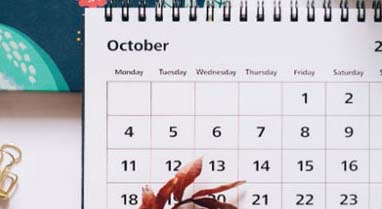Prepositions with Days, Months, and Years
In English, you use certain prepositions to show the day, month, and year (for example, on Tuesday, in January, in 2025).
There is no clear explanation why you use different prepositions, but there are some general rules. The best way to learn which preposition to use is to use them frequently until it becomes natural.

Olya Kobruseva | Pexels
Video Activity
Use “On” with Days
Use on with days of the week (e.g., on Sunday, on Monday, and so on).
Use on with days of the month (e.g., on the 1st, on the 25th, and so on).
To make the day more exact, you can add the month to it. You are still talking about a specific day, so you use the preposition on (for example, on January 1, on September 25, and so on ).
To make the day very exact, you include all the information. It is still a day so you use on (for example, on April 3, 2025, or on Monday, December 15, 2025).
Using “on” with days
- I have English classes on Mondays and Wednesdays.
- I always visit my grandparents on Sundays.
- I was born on January 5.
- World War I started on September 1, 1939.
- On July 4, 1776, the United States became independent from Great Britain.
- Kathy was born on Friday, July 3, 1998.
Use “In” with Months and Years
When talking about months, use the preposition in (for example, in January).
When talking about years, use in (for example, in 1990).
(Remember: If you add the day to the month, it is not a month anymore but a day in that month.)
Using “in” with months and years
With the month
- In the Northern Hemisphere, winter starts in December.
- Many people travel to Florida in January and February.
- My classes start in September.
- In July and August, it’s very hot in Texas.
- We moved to Colorado in April 2020.
With the year
- We moved here in 2020.
- The United States became independent from Great Britain in 1776.
- Kathy was born in 1998.
Assess Your Learning
Congratulations on completing this lesson!

Thanks to our supporters!
This material has been made possible by supporters like you. Learn how you can support us.

“What should I learn next?”
Use the buttons below to choose another skill or another lesson in this skill.
Thank you for Supporting Snap Language
Snap Language supporters make the creation of these materials possible.
Learn how you can support our work, get perks, and help us continue creating high-quality materials.
You can support us by simply white-listing this site.